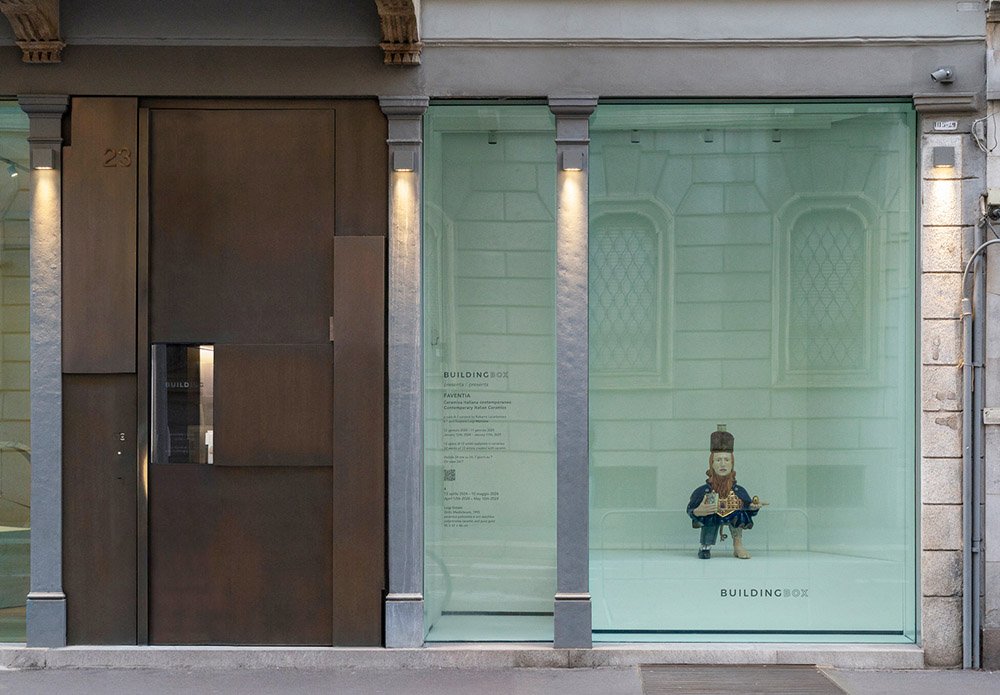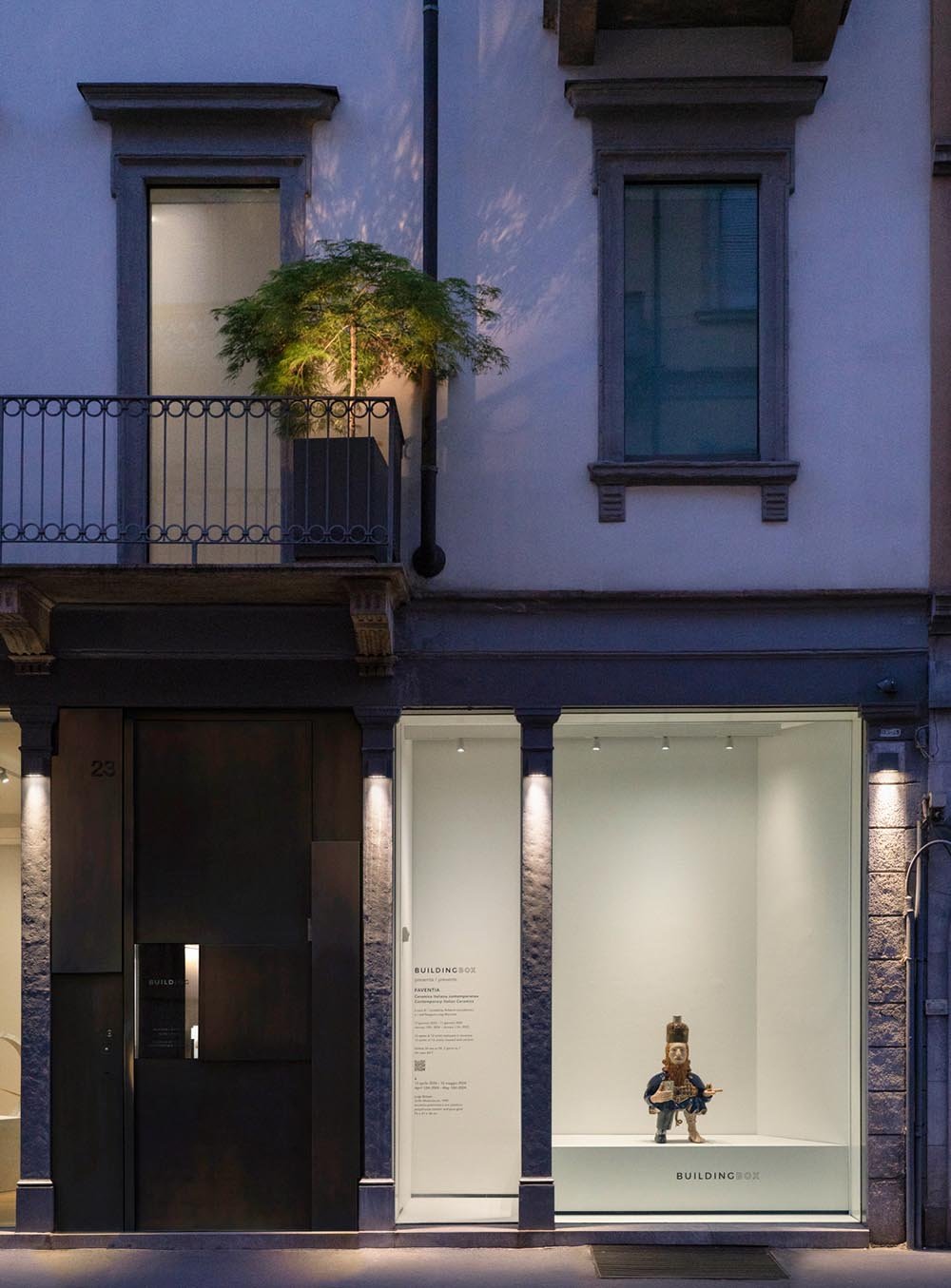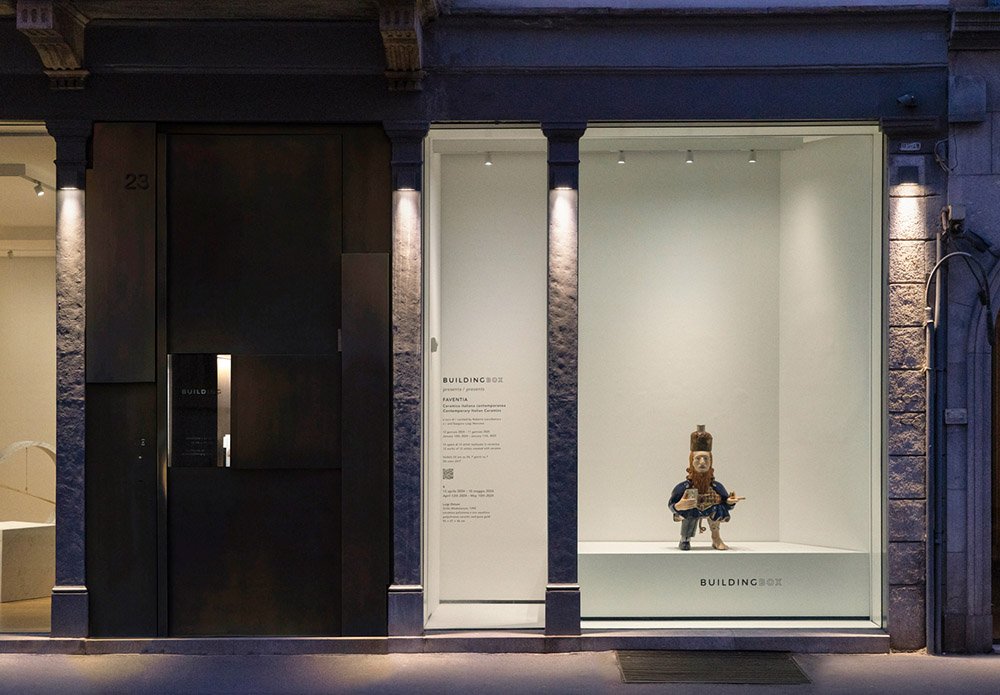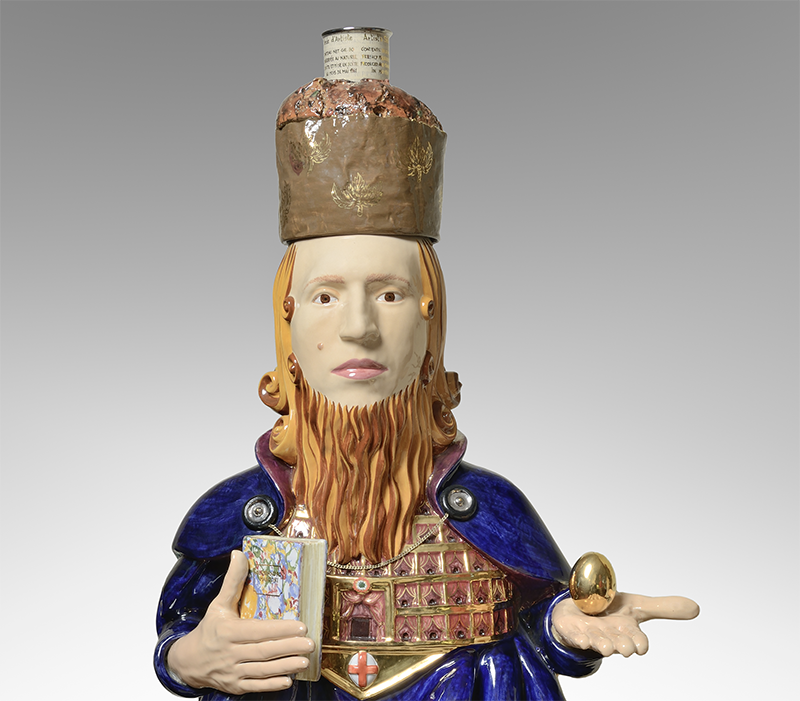FAVENTIA – 4/12. Luigi Ontani
12.04.2024 – 10.05.2024
From April 12th, 2024 to May 10th, 2024, BUILDINGBOX hosts the work Grillo Mediolanum (1995) by artist Luigi Ontani (Montovolo, 1943).
The fourth event of the exhibition FAVENTIA. Ceramica italiana contemporanea [Contemporary Italian Ceramics] is dedicated to the artwork Grillo Mediolanum (1995). The artist’s use of ceramics dates back to the 1980s (through to his collaboration with the Laboratorio Terraviva in Vietri sul Mare and with Venera Finocchiaro in Rome) and his relationship with the Faenza craftsmen – in particular with the Bottega d’Arte Ceramica Gatti since 1990 – led to the creation of numerous sculptures of an allegorical and mythological nature, and with frequent references to his own self-portrait, showing continuity with his performance work and his famous tableaux vivants.
The case of Grillo Mediolanum represents a playful tribute to the Lombard capital. Invited to present a project by the architect Italo Rota – at the time the Councillor for Urban Quality – Ontani created the sculpture depicting an anthropomorphic being which brought together various emblems of “Milanicity” – a genie with the features of the artist and a beard like that of Leonardo da Vinci – holding in one hand a copy of Alessandro Manzoni’s Promessi Sposi (1825-1842) and, in the other, a golden egg, a recurrent object in several works by the artist and a possible reference to Piero della Francesca’s Pala Montefeltro (1472-1474 circa), kept in the Pinacoteca di Brera, as well as to various “ovoid” works by Lucio Fontana, or Piero Manzoni, or to the artist’s birthplace (Montovolo). The bust of the statue is decorated with an ornamental motif reproducing the interior of the Teatro alla Scala and the figure is wearing a wide belt with the city coat of arms (a red cross on a white ground). On its head, there is a hat in the form of a panettone, topped by a reproduction of Piero Manzoni’s Merda d’artista (1961). The well-structured and ironic grouping of a great number of iconic citations and references, conceived by the artist in order to present a remarkable new “mascot” for the city, aroused considerable controversy and protests from the city council led by the mayor Marco Formentini. The object of public criticism and insults, it was pilloried in the street along corso Buenos Aires – it was nicknamed “bagonghi”, a circus dwarf – Ontani’s work was defended by Elio Fiorucci who declared that it well represented the spirit of Milan in its vivacity and irony, defining the work as “so modern that no one understands it”. Following these vicissitudes, the Grillo Mediolanum was exhibited in various contexts and museums – from the Palazzo della Ragione in Milan to the Castello di Rivoli – before finding a new home in an enlightened private collection.
From January 12th, 2024, to January 11th, 2025, BUILDINGBOX presents FAVENTIA. Ceramica italiana contemporanea [Contemporary Italian Ceramics], an exhibition project curated by Roberto Lacarbonara and Gaspare Luigi Marcone, involving twelve Italian artists invited to exhibit sculptures and installations made of ceramics. This programme is dedicated to the centuries-old artistic tradition of the city of Faenza, one of Italy’s main production districts, as well as the seat and epicentre of themed projects and museums such as the “MIC International Ceramics Museum”, the “Premio Faenza”, and the “Museo Carlo Zauli”. Furthermore, the exhibition was conceived as a tribute toward an area affected by the flood of May 2023.
As with BUILDINGBOX’s usual annual schedule, the exhibition hosts monthly interventions. In this edition, the artworks will be presented on the 12th day of each month. This “numerology” alludes to the cyclical nature and synthesis of earthly, spiritual, and temporal elements, as well as the numerous symbologies associated with the number 12 in history and cultures from different parts of the world.
The project maps and summarises some of the main artistic expressions related to the 20th and 21st centuries ceramics, promoting a series of artists from different generations who, consistently or sporadically with respect to their own production, use clay working techniques by continuing, recovering, or revolutionising the extraordinary manual skill of moulding, and the chromatic-luminist value of the glazes.
The ancient Faventia has been a land of artisan production since Roman times, a characteristic that was enhanced in later centuries. Indeed, it became synonymous of the majolica ceramics in many languages – French (faïance), English (faience). In recent years, many artists have used the Faenza kilns – also thanks to residency programmes, exhibitions, workshops, prizes, and publications – for the artistic production of medium and large-scale sculptures, often designed for an environmental development and installation purposes. The primal, demiurgic act of shaping the clay gives ceramics an exclusive status, almost an ontology, the auroral condition of sculpture. In the manipulation’s plastic immediacy that precedes the firing that crystallises the piece, there is all the naturalness of a slow, thoughtful transformation poised between design and chance. In ceramics, as in drawing, there is the seed of an origin, that appears on the surface of the image and things in the precise moment of their conception. Ceramics – beyond the categorisations between craft, art, functional objects, unique, or mass-produced piece – possesses an intermediary (or intermediality) between thought and gesture, sign and sculpture, form and colour, operating, moreover, with various natural elements such as earth, water, and fire; and by hybridising artistic languages, techniques, research, and knowledge between artists and artisans.








